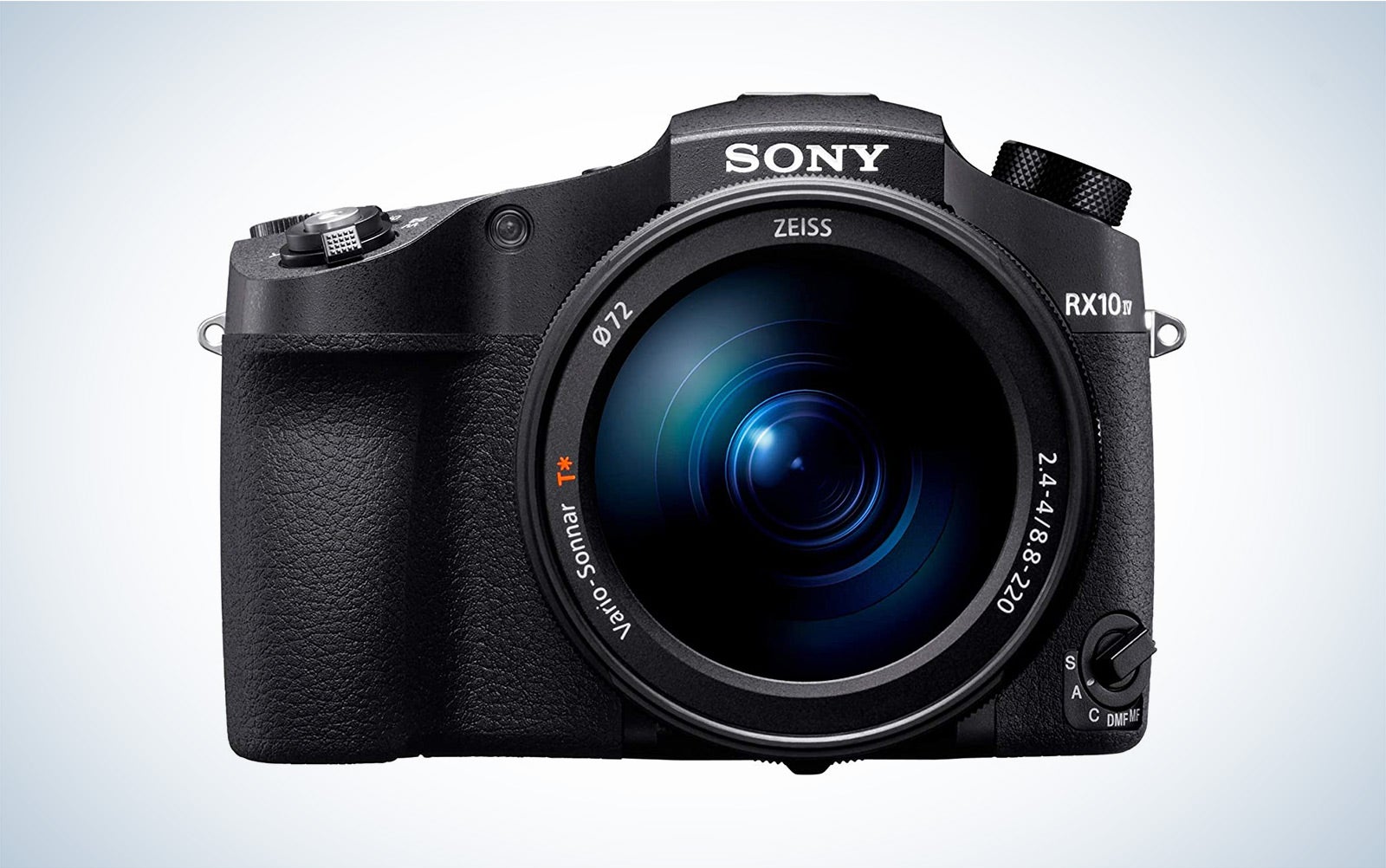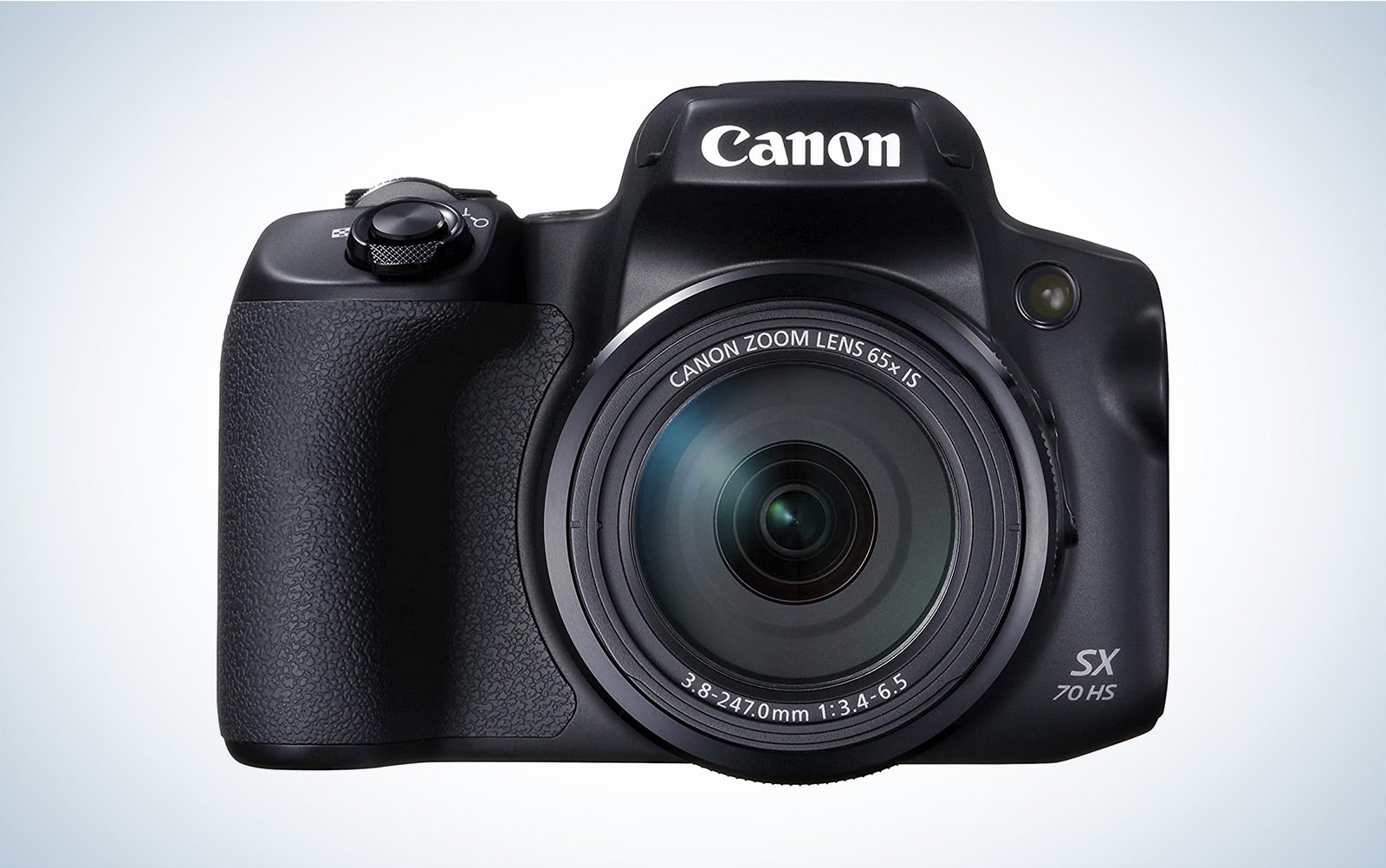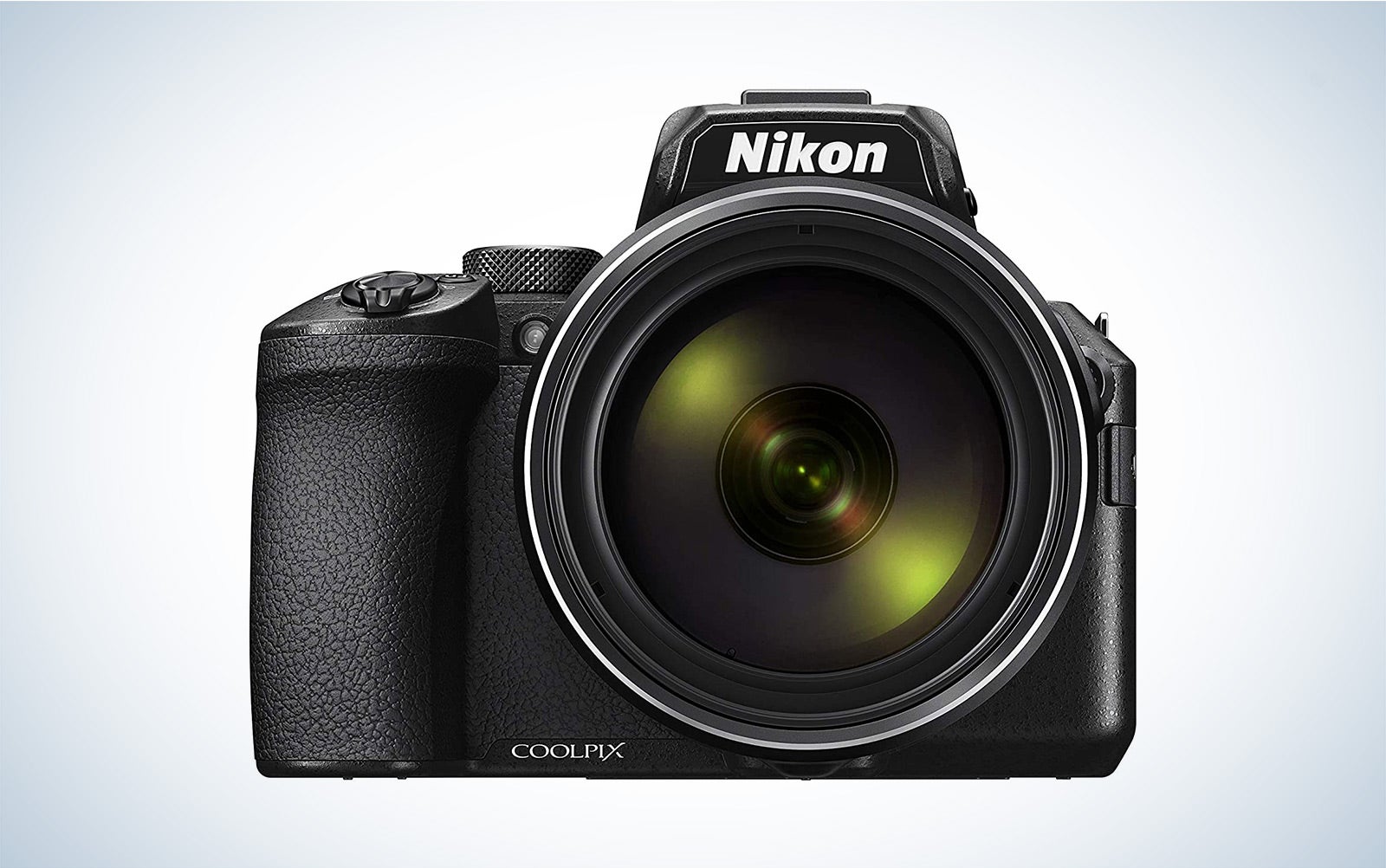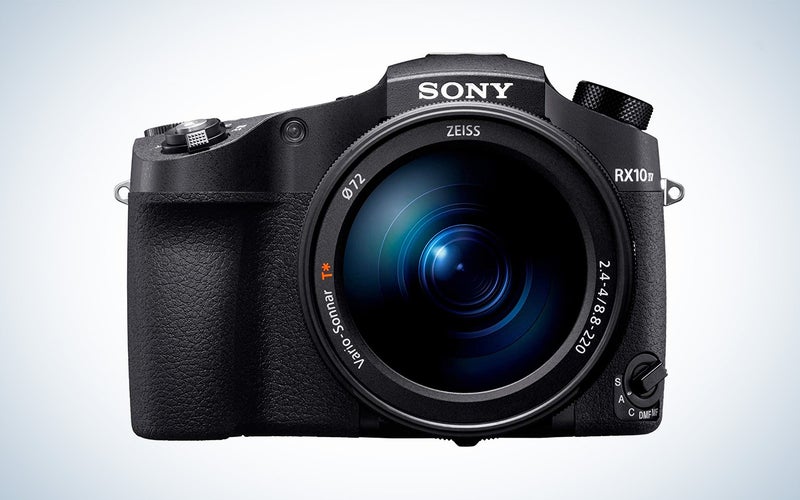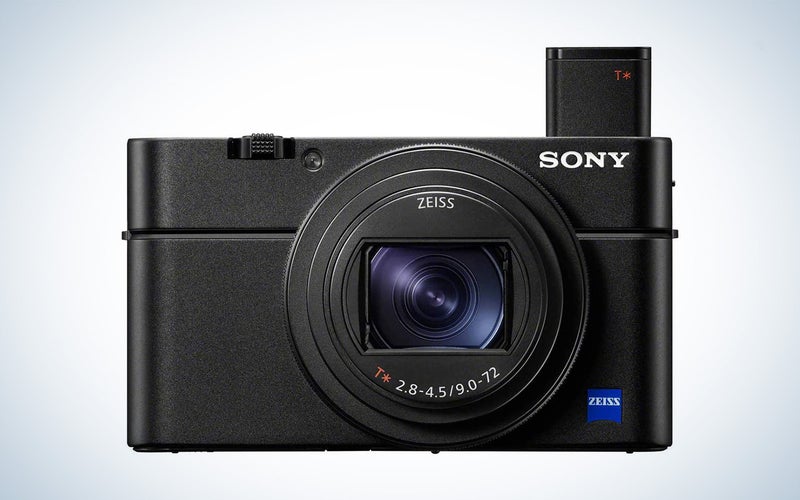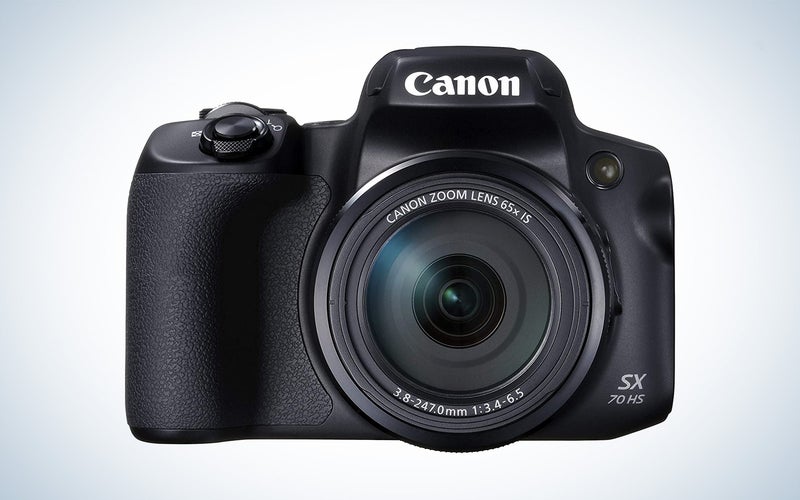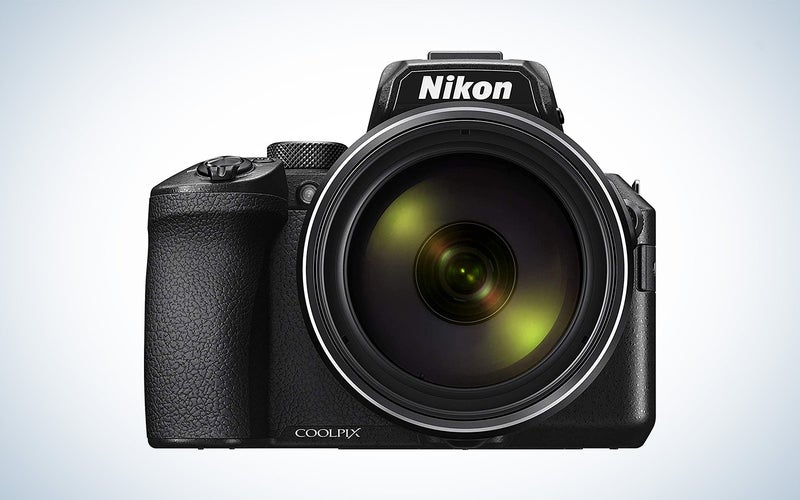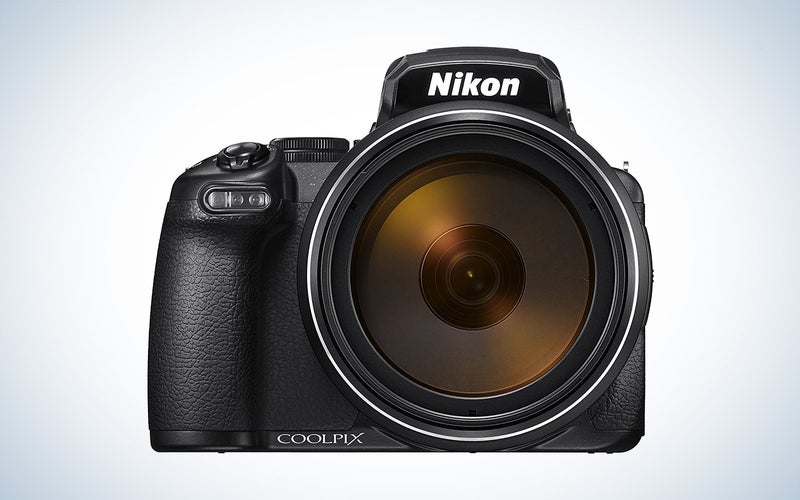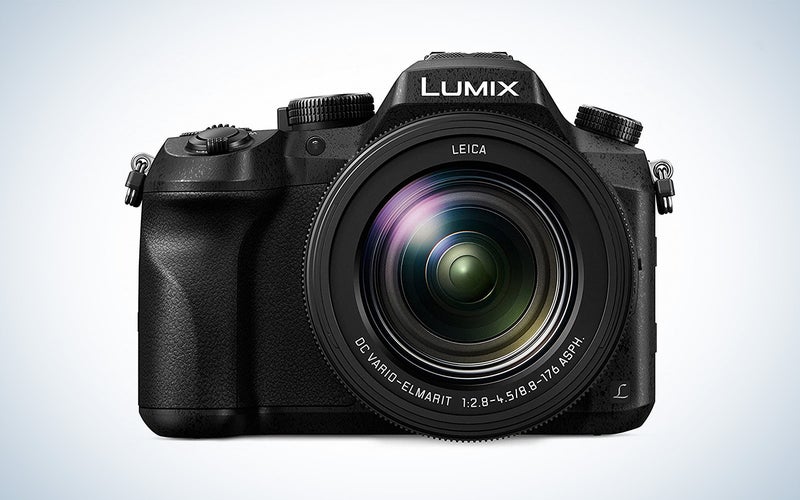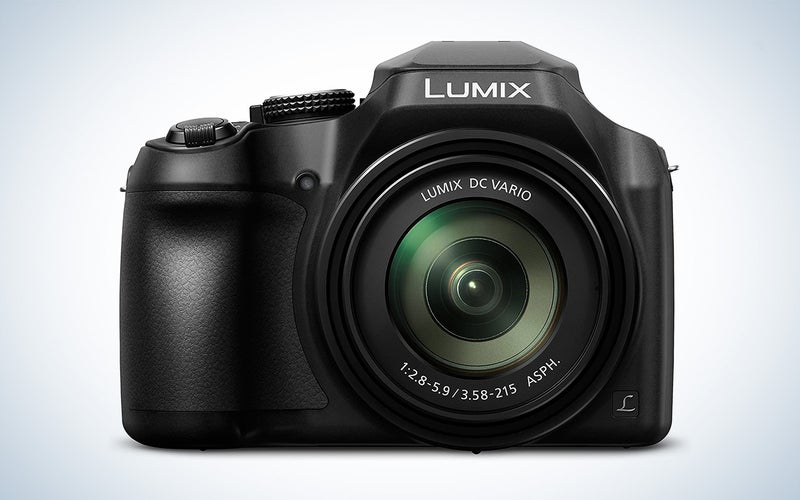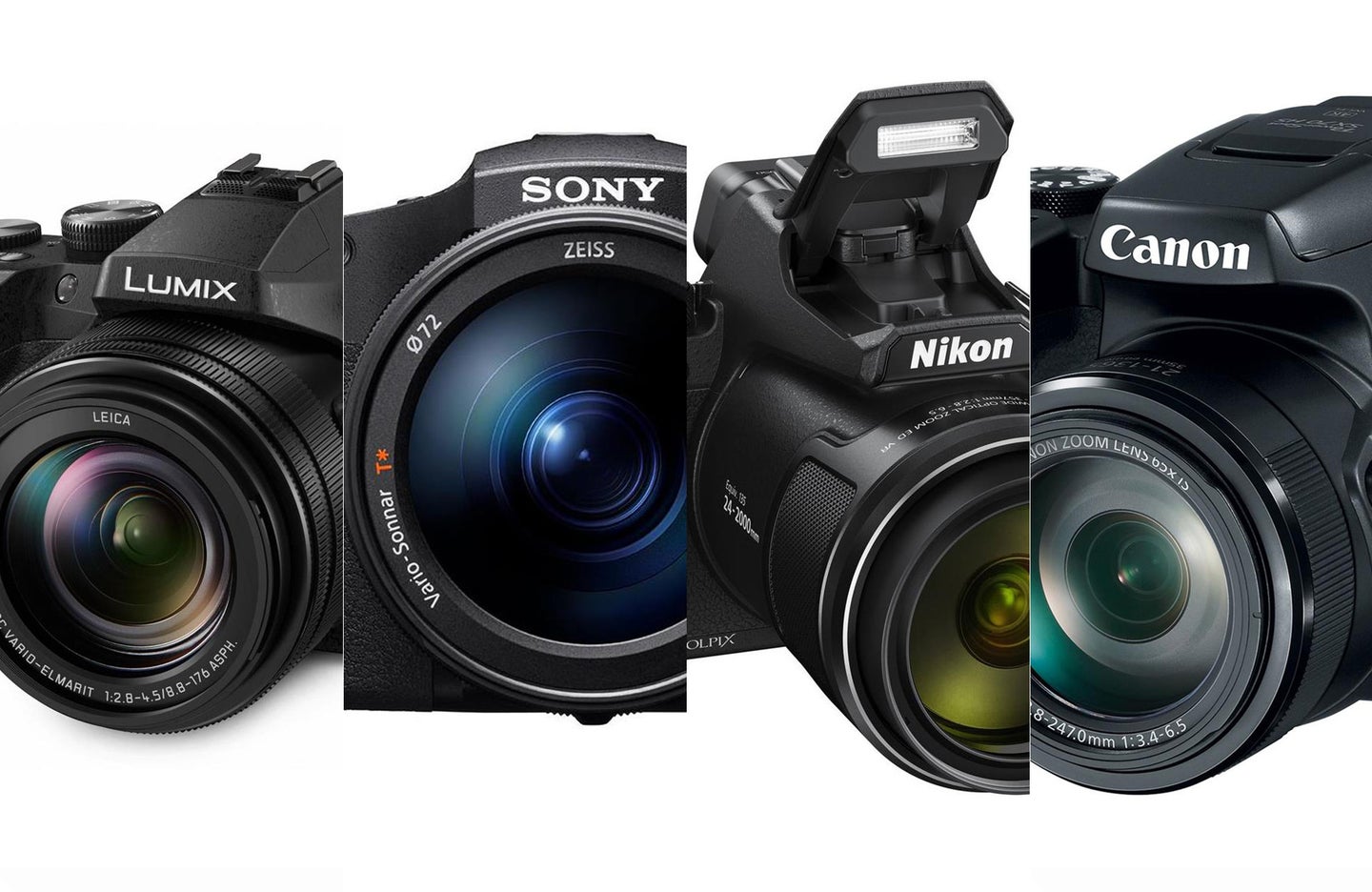
We may earn revenue from the products available on this page and participate in affiliate programs. Learn more ›
The best bridge cameras offer the flexibility and power of a system camera with the simplicity of an attached lens. They are called bridge cameras because they bridge the gap between simple point-and-shoot cameras with minimal control and interchangeable lens cameras (like mirrorless and DSLR options). Bridge cameras typically offer complete manual control of settings and a built-in lens with an extremely wide zoom range.
Bridge cameras provide an excellent option for those wanting to control exposure and image style without worrying about how to pack multiple lenses. The wide zoom range typically found in these cameras makes them terrific choices for all sorts of photography, from travel and wildlife to family snapshots. In addition, new versions are getting even more powerful with larger sensors and more megapixels, resulting in high-quality photos and videos coming from a relatively compact package.
- Best overall: Sony Cyber-shot DSC-RX10 IV
- Best overall runner up: Sony Cyber-shot DSC-RX100 VII
- Best for wildlife: Canon PowerShot SX70 HS
- Best superzoom: Nikon COOLPIX P950
- Best superzoom runner up: Nikon COOLPIX P1000
- Best 4k camera: Panasonic Lumix FZ2500
- Best budget: Panasonic Lumix FZ80
How we chose the best bridge cameras
The editors and writers at Popular Photography have decades of photography experience in just about every genre and have covered and reviewed just about every major camera on the market. When selecting the best bridge cameras, we looked at various features. For example, because bridge cameras don’t have interchangeable lenses, we prioritized options with wide zoom ranges. We also looked at standard image quality metrics, such as megapixel count, sensor size, and lens quality. Since many users like the option of recording video, video capabilities also were factored in. Lastly, performance-related features like frames per second and the ergonomics of the camera were also part of the considerations.
The best bridge cameras: Reviews & Recommendations
Best overall: Sony Cyber-shot DSC-RX10 IV
Sony
Why it made the cut: Sony’s RX10 IV is a powerful camera with 4K and slow-motion video, 24fsp continuous shooting while tracking subjects, and fast autofocus. The small DSLR-like body makes it easy to hold, while the wide zoom range makes this camera an excellent fit for all sorts of situations.
Specs
- Sensor size: 1 inch
- Megapixels: 20.1 megapixels
- Lens: 8.8 to 220mm (35mm equivalent focal length: 24 to 600mm) f/2.4 to f/4
- Maximum continuous shooting rate: 24fps
Pros
- Dust and splash resistant
- 4K video and 1080p slow-motion
- Fast autofocus with tracking
- Good handgrip for holding for long periods of time
- Fast lens with useful zoom range
Cons
- Expensive
The RX10 IV is a powerhouse choice for the best bridge camera. The large 1 inch, stacked design sensor supports an ISO of up to 12800, aiding in lowlight situations. The sensor also allows for phase detect AF, which is a more reliable and faster autofocus system. It can shoot 24 fps with autofocus tracking, helpful for capturing action and nailing the shot at critical moments. The weather-sealing on this camera means you can worry less when taking it out and about.
The lens in the RX10 IV has a versatile 25x zoom with a max focal length of 600mm (35mm equivalent). The in-lens stabilization helps support the long zoom and offers 4.5 stops of stabilization. In addition, it has a fast maximum aperture of f/2.4 when zoomed out, making it easier to achieve that shallow depth of field and helping with dark conditions. And this lens isn’t just good for capturing things at a distance. It is capable of macro shots and can focus as close as 1.2 inches when zoomed out and 2.4 feet when zoomed in. This versatility in a lens will allow you to capture a full spectrum of subject matter.
Best overall runner up: Sony Cyber-shot DSC-RX100 VII
Sony
Why it made the cut: The RX100 VII offers a redesigned 20.1MP 1-inch sensor and an upgraded image processor for fast shooting. The quick autofocus and 4K video make this a well-rounded choice.
Specs
- Sensor size: 1-inch
- Megapixels: 20.1 megapixels
- Lens: 9-72mm (35mm equivalent: 24-200mm) f/2.8 to f/4.5
- Maximum continuous shooting rate: 24fps
Pros
- 4K video and 1080p slow-motion
- Fast autofocus with tracking
- Lightweight and pocketable
- Fast lens with useful zoom range
Cons
- Expensive
Chances are you’ve recently seen the RX100 VII at the top of many camera lists, and for many good reasons. This camera is a heavy hitter in terms of features and quality, thanks to the new sensor and BIONZ X image processor similar to the chip found in more advanced mirrorless cameras. In addition, it has double the maximum continuous shooting of its competitors at 24fps and paired with fast autofocus this camera is excellent for documenting action. And it’s capable of 4K video and 1080p slow-motion 240 fps so that you can capture both quality photos and video.
This newest iteration of the RX100 has a ZEISS Vario-Sonnar lens with a useful 24-200mm zoom range. The maximum aperture of f/2.8 to f/4.5 helps in lowlight conditions and creates a nice shallow depth of field when you want to. In addition, it has ISO sensitivity up to 12800, helping even more with those dark conditions. All of these features and tech are packed into one of the lightest bodies (10.65 oz) available for a bridge camera, making this a great option for those on the go who still want excellent quality.
Best for wildlife: Canon PowerShot SX70 HS
Canon
Why it made the cut: With 65x zoom, 20.3 megapixels, and the ability to shoot raw in a lightweight, easy-to-hold body, the PowerShot SX70 is ready for wildlife expeditions.
Specs
- Sensor size: 1/2.3 inch
- Megapixels: 20.3 megapixels
- Lens: 3.8 to 247.0 mm (35 mm equivalent: 21 to 1365 mm) f/3.4 to f/6.5
- Maximum continuous shooting rate: 10fps
Pros
- 65x zoom range
- Vari-angle screen
- 4K video
- Excellent ergonomics
Cons
- Not great in low light
Canon’s Powershot SX70 HS is more of a traditional bridge camera with its 1/2.3-inch sensor. However, despite the small sensor size, you still get 20.3 megapixels, resulting in high-quality images. The built-in image stabilization helps get sharp photos, especially when utilizing the 65x zoom, which provides a full-frame equivalent range of 21 to 1365 mm. In addition, the SX70 HS can shoot 4K video, which will come in handy for producing footage of your birding trips.
The SX70 HS is limited in low light capabilities due to a max ISO of 3200 and a max aperture when zoomed-in of f/6.5. But, the small size and nice handgrip on the body make for better ergonomics so that you can hold the camera comfortably for extended periods. If you’re shooting wildlife during the day, that slow aperture shouldn’t prove much of a hindrance anyway.
Best superzoom: Nikon COOLPIX P950
Nikon
Why it made the cut: The Coolpix 950 has one of the most impressive zoom lenses in the category, coming in at 83x. In addition, the ability to shoot raw images and shoot 4K makes this the best bridge camera if you are looking for a big telephoto range.
Specs
- Sensor size: 1/2.3 inch
- Megapixels: 16 megapixels
- Lens: 4.3 to 357mm (35 mm equivalent: 24 to 2000mm) f/2.8 to f/6.5
- Maximum continuous shooting rate: 7fps
Pros
- 83x zoom
- Raw format shooting
- 4K video
Cons
- Heavier than other options
The Coolpix 950 is an updated version of the P900, and with the update came some excellent additions. You now get full raw capture abilities and 4K video. Nikon also upgraded and improved the electronic viewfinder on the P950, doubling the size and bringing the resolution up significantly to a 2,359,000-dot OLED. The larger size and higher resolution make it easier to compose and expose your images.
The P950 has 83x zoom, but if that isn’t enough, it also has 166x Dynamic Fine Zoom, bringing up the focal length to 4000mm equivalent. When fully zoomed in, you can fill up the frame with the moon; it’s almost like having a telescope. Luckily the camera also has excellent image stabilization to help prevent blur when utilizing the extreme zoom. Even with that vibration reduction, however, you’re going to want a tripod to take full advantage of the reach.
Best superzoom runner up: Nikon COOLPIX P1000
Nikon
Why it made the cut: If the zoom of the Coolpix P950 somehow isn’t enough for you, the P1000 has a 125x zoom, resulting in a staggering 24-3000mm range.
Specs
- Sensor size: 1/2.3 inch
- Megapixels: 16 megapixels
- Lens: 4.3 to 539mm (35mm equivalent: 24 to 3000mm) f/2.8 to f/8
- Maximum continuous shooting rate: 7fps
Pros
- Massive 125x zoom
- Raw captures
- 4K video
- Five-stop VR system
Cons
- Very large compared to other bridge cameras
- Small maximum aperture when zoomed in
The Coolpix P1000 brings a whole new meaning to superzoom. It has a 35mm equivalent lens of 24-3000mm, and a digital zoom that can bring that to an absurd 6000mm. Luckily, this camera has Nikon’s Dual Detect VR, which can reduce shake by up to five stops, which is extremely helpful when shooting at the high zoom range.
Unfortunately, as you zoom in on the P1000, you lose three full aperture stops, with f/8 being the maximum aperture when fully zoomed. The image quality also fades as you zoom in, which is a downside. But, it can take raw images and 4K videos. If being able to zoom in extreme amounts is your primary focus, this camera model will be your best bet. For most people, the P950 is plenty, but if you really need the reach, you can step up to this model.
Best 4K camera: Panasonic Lumix FZ2500
Panasonic
Why it made the cut: This camera is capable of 4k video at 30fps and boasts an HDMI port for 10-bit, 4:2:2 output, making it an excellent compact for vloggers and videographers.
Specs
- Sensor size: 1 inch
- Megapixels: 20.9 megapixels
- Lens: 8.8 to 176mm (35mm equivalent: 24 to 480mm) f/2.8 to f/4.5
- Maximum continuous shooting rate: 12fps
Pros
- 1 inch sensor
- Quick autofocus
- 4K video
- Built-in variable ND filter
Cons
- Less than impressive lens
When Panasonic released the FZ2500, it was clear that they designed this camera for video enthusiasts. It is capable of 4K video recording at 30 fps and 1080p up to 60 fps. The camera also offers a built-in variable density neutral density filter. The ND filter will allow you to use proper shutter speeds while recording without having to bring along separate filters. It can also come in handy with stills if you want to shoot longer exposures in brighter settings
The FZ2500 has a solid zoom range of 60x; although it isn’t as large as other bridge cameras, it is plenty for most situations. The larger 1-inch sensor in this camera and megapixel count of 20.9 help to produce excellent image quality. It has a minimum focusing distance of just 3cm, making it useful for those macro shots. To help even more with macro images, the FZ2500 comes with Focus Stacking mode. This mode allows you to adjust the focus after the fact by taking multiple photos at slightly different focus points. That’s very helpful in macro settings where depth of field gets extremely shallow.
Best budget: Panasonic Lumix FZ80
Panasonic
Why it made the cut: For those wanting a good all-around bridge camera with full manual controls at a budget price, the Lumix FZ80 delivers. It has 4k video recording, raw capture, and Panasonic’s 4K photo mode that allows for high-speed image capture.
Specs
- Sensor size: 1/2.3 inch
- Megapixels: 18.9 megapixels
- Lens: 3.6 to 215mm (35mm equivalent: 20 to 1200mm) f/2.8 to f/5.9
- Maximum continuous shooting rate: 10fps
Pros
- 60x zoom range
- Fast autofocus
- 4K video
- Highly affordable
Cons
- No eye sensor on the electronic viewfinder
- Fixed LCD display
The Lumix FZ80 comes in at an affordable price but retains plenty of features and quality. For example, you still get 4K video recording for those interested in video creation. Plus, you can take advantage of the 4K photo mode, which produces 8MP images at 30fps. In addition, the autofocus in the FZ80 is speedy, especially in bright lighting conditions, helping to capture the action.
The lens on the FZ80 is slightly wider than other bridge cameras and still has an excellent zoom of 60x. Unfortunately, this camera doesn’t perform the best at higher ISOs, with noticeable noise cropping up, in part due to the smaller 1/2.3 inch CMOS sensor. Shooting in raw can help with the noise, however. It also has Wi-Fi connectivity to easily transfer your captures from the camera to your phone for quick sharing.
Things to consider before buying the best bridge cameras
Zoom range
Bridge cameras don’t have interchangeable lenses, so you’ll need to think more about the focal lengths you want to use before purchasing. Your photographic needs will dictate how much zoom you really need. Some offer massive zoom ranges that push into telescope territory. Those models typically rely on smaller sensors or bigger form factors to achieve those feats. Opting for a smaller zoom allows the camera to employ a bigger sensor that can improve overall image quality and allow for larger maximum apertures. . Certain types of photography, such as wildlife, may require more telephoto range than other subjects, like family photos.
Manual controls
Some advanced bridge cameras offer nearly everything you’d find on a mirrorless camera or DSLR. That includes manual exposure modes and customizable controls on the camera body itself. Even if you’re not ready to take advantage of these options now, they may come in handy as you improve your photography skills.
Weather sealing
Bridge cameras make great travel companions because of their compact nature, whether a casual family vacation or a bigger adventure. Because of that, weather sealing could be an essential factor. Therefore, if you plan on taking your camera in rough conditions, you will want a camera with excellent weatherproofing. However, if you intend to use it for shorter trips and everyday situations, you can skip the weatherproofing and perhaps save yourself some money.
Image quality
As with any camera purchase, you need to consider how high quality you want your images. If your camera will be for casual use documenting memories and you will not be printing much, you can save a bit of money and go with a smaller sensor size and fewer megapixels. However, if you want to get the most quality out of your bridge camera, go with the 1-inch sensor and higher megapixel count.
FAQs
Q: Do bridge cameras have interchangeable lenses?
Bridge cameras do not have interchangeable lenses. However, they typically are outfitted with a lens with an impressive zoom range, making them versatile despite the inability to swap out lenses.
Q: Which is the best bridge camera to buy?
We’ve found the Sony RX100 VII to be the best bridge camera available. The combination of quality and features for a reasonable price makes it well-rounded for all sorts of photography.
Q: Are bridge cameras good for photography?
Bridge cameras are an excellent option for photography. While they won’t have the large sensor found in interchangeable lens cameras, the quality is still fantastic in most, and they are more compact and portable.
Final thoughts on the best bridge cameras
The best bridge camera will be a flexible piece of camera equipment to help you capture great images in a wide range of situations. They are great for travel due to their compact size and integrated lens, and many offer advanced features for complete control. Deciding which is best for you will depend on your budget, the types of photography you are likely to focus on, and how you intend to use the final images or video.
The post The best bridge cameras in 2023 appeared first on Popular Photography.
Articles may contain affiliate links which enable us to share in the revenue of any purchases made.
